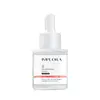What's inside
What's inside
 Key Ingredients
Key Ingredients

 Benefits
Benefits

 Concerns
Concerns

No concerns
 Ingredients Side-by-side
Ingredients Side-by-side

Water
Skin ConditioningButylene Glycol
HumectantPropylene Glycol
HumectantGlycerin
HumectantEthoxydiglycol
HumectantPolyacrylate-13
Polyisobutene
Sodium PCA
HumectantSodium Lactate
BufferingDMDM Hydantoin
PreservativePropanediol
SolventHydroxypropyl Methylcellulose
Emulsion StabilisingHydrolyzed Collagen
Emollient1,2-Hexanediol
Skin ConditioningTetrasodium EDTA
Polysorbate 20
EmulsifyingGlycogen
HumectantSorbitan Isostearate
EmulsifyingTriethanolamine
BufferingPhenoxyethanol
PreservativeSodium Dna
Skin ConditioningLactic Acid
BufferingGlycine
BufferingUrea
BufferingFructose
HumectantInositol
HumectantNiacinamide
SmoothingIodopropynyl Butylcarbamate
PreservativeSodium Benzoate
MaskingChlorphenesin
AntimicrobialAloe Barbadensis Leaf Extract
EmollientSodium Chloride
MaskingBenzoic Acid
MaskingDisodium EDTA
Ecklonia Cava Water
Skin ProtectingWater, Butylene Glycol, Propylene Glycol, Glycerin, Ethoxydiglycol, Polyacrylate-13, Polyisobutene, Sodium PCA, Sodium Lactate, DMDM Hydantoin, Propanediol, Hydroxypropyl Methylcellulose, Hydrolyzed Collagen, 1,2-Hexanediol, Tetrasodium EDTA, Polysorbate 20, Glycogen, Sorbitan Isostearate, Triethanolamine, Phenoxyethanol, Sodium Dna, Lactic Acid, Glycine, Urea, Fructose, Inositol, Niacinamide, Iodopropynyl Butylcarbamate, Sodium Benzoate, Chlorphenesin, Aloe Barbadensis Leaf Extract, Sodium Chloride, Benzoic Acid, Disodium EDTA, Ecklonia Cava Water
Water
Skin ConditioningNiacinamide
SmoothingGlycerin
HumectantHydroxyethyl Urea
HumectantBetaine
HumectantMethyl Gluceth-20
HumectantEthoxydiglycol
HumectantPropanediol
SolventPhenoxyethanol
PreservativeBiosaccharide Gum-1
HumectantHydroxyethyl Acrylate/Sodium Acryloyldimethyl Taurate Copolymer
Emulsion StabilisingPolyacrylate-1 Crosspolymer
Acetyl Glycyl Beta-Alanine
Skin ConditioningAllantoin
Skin ConditioningPisum Sativum Extract
Skin ConditioningEthylhexylglycerin
Skin ConditioningDisodium EDTA
Tocopheryl Acetate
AntioxidantSodium Hyaluronate
HumectantChenopodium Quinoa Seed Extract
Skin ConditioningWater, Niacinamide, Glycerin, Hydroxyethyl Urea, Betaine, Methyl Gluceth-20, Ethoxydiglycol, Propanediol, Phenoxyethanol, Biosaccharide Gum-1, Hydroxyethyl Acrylate/Sodium Acryloyldimethyl Taurate Copolymer, Polyacrylate-1 Crosspolymer, Acetyl Glycyl Beta-Alanine, Allantoin, Pisum Sativum Extract, Ethylhexylglycerin, Disodium EDTA, Tocopheryl Acetate, Sodium Hyaluronate, Chenopodium Quinoa Seed Extract
Ingredients Explained
These ingredients are found in both products.
Ingredients higher up in an ingredient list are typically present in a larger amount.
Disodium EDTA plays a role in making products more stable by aiding other preservatives.
It is a chelating agent, meaning it neutralizes metal ions that may be found in a product.
Disodium EDTA is a salt of edetic acid and is found to be safe in cosmetic ingredients.
Learn more about Disodium EDTAEthoxydiglycol is a synthetic solvent.
Solvents are used to keep ingredients together in a product. They can help dissolve ingredients to stable bases or help evenly distribute ingredients throughout the product.
Ethoxydiglycol also helps deliver other key ingredients into the skin.
Learn more about EthoxydiglycolGlycerin is already naturally found in your skin. It helps moisturize and protect your skin.
A study from 2016 found glycerin to be more effective as a humectant than AHAs and hyaluronic acid.
As a humectant, it helps the skin stay hydrated by pulling moisture to your skin. The low molecular weight of glycerin allows it to pull moisture into the deeper layers of your skin.
Hydrated skin improves your skin barrier; Your skin barrier helps protect against irritants and bacteria.
Glycerin has also been found to have antimicrobial and antiviral properties. Due to these properties, glycerin is often used in wound and burn treatments.
In cosmetics, glycerin is usually derived from plants such as soybean or palm. However, it can also be sourced from animals, such as tallow or animal fat.
This ingredient is organic, colorless, odorless, and non-toxic.
Glycerin is the name for this ingredient in American English. British English uses Glycerol/Glycerine.
Learn more about GlycerinNiacinamide is a multitasking form of vitamin B3 that strengthens the skin barrier, reduces pores and dark spots, regulates oil, and improves signs of aging.
And the best part? It's gentle and well-tolerated by most skin types, including sensitive and reactive skin.
You might have heard of "niacin flush", or the reddening of skin that causes itchiness. Niacinamide has not been found to cause this.
In very rare cases, some individuals may not be able to tolerate niacinamide at all or experience an allergic reaction to it.
If you are experiencing flaking, irritation, and dryness with this ingredient, be sure to double check all your products as this ingredient can be found in all categories of skincare.
When incorporating niacinamide into your routine, look out for concentration amounts. Typically, 5% niacinamide provides benefits such as fading dark spots. However, if you have sensitive skin, it is better to begin with a smaller concentration.
When you apply niacinamide to your skin, your body converts it into nicotinamide adenine dinucleotide (NAD). NAD is an essential coenzyme that is already found in your cells as "fuel" and powers countless biological processes.
In your skin, NAD helps repair cell damage, produce new healthy cells, support collagen production, strengthen the skin barrier, and fight environmental stressors (like UV and pollution).
Our natural NAD levels start to decline with age, leading to slower skin repair, visible aging, and a weaker skin barrier. By providing your skin niacinamide, you're recharging your skin's NAD levels. This leads to stronger, healthier, and younger looking skin.
Another name for vitamin B3 is nicotinamide. This vitamin is water-soluble and our bodies don't store it. We obtain Vitamin B3 from either food or skincare. Meat, fish, wheat, yeast, and leafy greens contain vitamin B3.
The type of niacinamide used in skincare is synthetically created.
Learn more about NiacinamidePhenoxyethanol is a preservative that has germicide, antimicrobial, and aromatic properties. Studies show that phenoxyethanol can prevent microbial growth. By itself, it has a scent that is similar to that of a rose.
It's often used in formulations along with Caprylyl Glycol to preserve the shelf life of products.
Propanediol is an all-star ingredient. It softens, hydrates, and smooths the skin.
It’s often used to:
Propanediol is not likely to cause sensitivity and considered safe to use. It is derived from corn or petroleum with a clear color and no scent.
Learn more about PropanediolWater. It's the most common cosmetic ingredient of all. You'll usually see it at the top of ingredient lists, meaning that it makes up the largest part of the product.
So why is it so popular? Water most often acts as a solvent - this means that it helps dissolve other ingredients into the formulation.
You'll also recognize water as that liquid we all need to stay alive. If you see this, drink a glass of water. Stay hydrated!
Learn more about Water